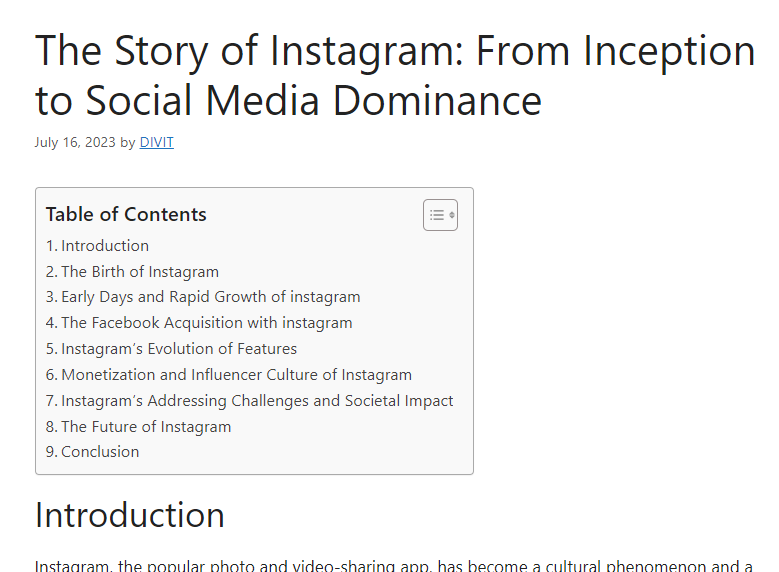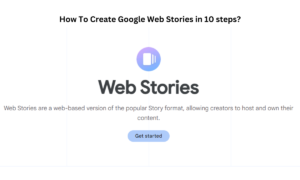Introduction
Instagram, the popular photo and video-sharing app, has become a cultural phenomenon and a dominant force in the world of social media. Since its inception in 2010, Instagram has undergone a remarkable journey, revolutionizing the way we capture, share, and experience visual content. In this comprehensive 4000-word article, we will take a deep dive into the captivating story of Instagram, exploring the story of Instagram its history, startup journey, key milestones, transformative features, expansion, ownership changes, monetization strategies, societal impact, and the future outlook. From its humble beginnings as a small startup to its current status as a global powerhouse, Instagram has left an indelible mark on the digital landscape, reshaping how we connect, communicate, and share our lives.
The Birth of Instagram
The story of Instagram begins with the entrepreneurial journey of Kevin Systrom and Mike Krieger, two individuals with a shared passion for technology and photography. The seeds of Instagram were sown during their time at Stanford University, where they crossed paths and developed a friendship based on their mutual interests.
Kevin Systrom, a native of Massachusetts, had a keen interest in programming and technology from a young age. He had a particular fascination with photography and even interned at Odeo, a startup founded by Twitter co-founder Evan Williams. This experience exposed Systrom to the world of startups and ignited his entrepreneurial spirit.
Mike Krieger, on the other hand, was born in São Paulo, Brazil, and moved to the United States to pursue a degree in computer science at Stanford University. Krieger had a strong background in programming and a knack for developing innovative solutions.
It was during their time at Stanford that Systrom and Krieger became friends and realized they shared a passion for photography and mobile technology. Systrom had been working on a project called Burbn, a mobile app that combined elements of location-based check-ins, gaming, and photo sharing. While Burbn showed promise, the duo recognized the need to simplify and focus the app to make it more appealing to users.
Inspired by their shared love for photography and the desire to create a platform that would allow users to capture and share moments in a more streamlined manner, Systrom and Krieger made the pivotal decision to pivot Burbn into a dedicated photo-sharing app. This decision laid the foundation for what would eventually become Instagram.
In October 2010, Instagram was officially launched to the public. The app, initially available exclusively on iOS, boasted an intuitive and user-friendly interface that made capturing and sharing photos effortless. It also introduced a range of filters that allowed users to enhance their photos with various visual effects, adding a creative touch to their images.
The timing of Instagram’s launch was opportune. Mobile photography was gaining traction, and social media platforms were evolving beyond text-based communication. Instagram filled a gap in the market by offering a simple and visually appealing way for users to share their daily moments and artistic creations.
The response to Instagram was immediate and overwhelmingly positive. Within just 24 hours of its launch, the app had attracted 25,000 users. Its popularity continued to soar, and by December 2010, Instagram surpassed one million registered users—a remarkable achievement for such a young platform.
The success of the story of Instagram can be attributed to its focus on simplicity, visual aesthetics, and the ability to connect users through the universal language of photography. It tapped into the innate human desire to capture and share moments, fostering a sense of community and creativity.
Little did Systrom and Krieger know that their small photo-sharing app would go on to revolutionize the way we communicate and share our lives. The birth of Instagram marked the beginning of a digital revolution—one that would shape the future of social media and inspire millions of users to become visual storytellers.
The journey of Instagram had only just begun, and it would continue to evolve, innovate, and leave an indelible mark on the world of technology and social media.
Early Days and Rapid Growth of instagram
Following its launch in October 2010, Instagram experienced a rapid and unprecedented growth that would solidify its position as one of the most popular social media platforms in the world. The early days of Instagram were marked by a surge in user adoption, impressive engagement levels, and the emergence of a vibrant community centered around visual storytelling.
The simplicity and intuitive design of Instagram’s interface played a crucial role in its rapid growth. The app’s clean layout and straightforward navigation made it easy for users to capture, edit, and share photos with just a few taps. Instagram also introduced a range of filters that allowed users to enhance their images and add a touch of creativity to their posts.
Within hours of its launch, Instagram gained significant attention and traction. The app’s user base grew rapidly as thousands of users flocked to the platform to explore its unique features and share their visual narratives. Celebrities, influencers, and everyday users embraced Instagram as a new and exciting medium for self-expression.
Instagram’s growth was not limited to individual users. Businesses and brands quickly recognized the platform’s potential as a marketing tool and began to leverage its visual nature to showcase products, engage with customers, and build brand identity. Early adopters of Instagram included well-known brands such as Nike, Starbucks, and National Geographic, who utilized the platform to connect with their target audience in a more authentic and visually compelling manner.
By December 2010, just two months after its launch, Instagram achieved an impressive milestone by surpassing one million registered users. This rapid growth demonstrated the immense appeal and demand for a platform that combined the power of photography, creativity, and social interaction.
Instagram’s success can be attributed to its ability to tap into the evolving trends in mobile technology and social media. The rise of smartphones equipped with increasingly advanced cameras, coupled with the growing popularity of photo-sharing on social platforms, created the perfect environment for Instagram to thrive. The app provided a seamless and immersive experience that catered to users’ desire for visual expression and connection.
The early days of Instagram were also marked by the emergence of a passionate and engaged user community. Users not only shared their own photos but also discovered and interacted with content from others. This sense of community fostered a spirit of collaboration, inspiration, and support, as users exchanged likes, comments, and followed each other’s accounts. Instagram became a hub for creative individuals, hobbyists, professional photographers, and enthusiasts to connect, learn, and be inspired by one another.
In conclusion, the early days of Instagram were characterized by a meteoric rise in user adoption, driven by the app’s user-friendly design, innovative features, and the innate human desire to capture and share moments visually. Instagram’s ability to tap into the growing trends in mobile photography and social media set the stage for its continued success and eventual transformation into a global social media powerhouse.
The Facebook Acquisition with instagram
One of the most significant milestones in the story of Instagram was its acquisition by Facebook in April 2012. This acquisition marked a turning point for both Instagram and the broader social media landscape, propelling Instagram to even greater heights while solidifying Facebook’s position as a dominant player in the industry.
The decision to acquire Instagram was driven by several key factors. First and foremost, Facebook recognized the explosive growth and potential of Instagram as a visual platform for sharing moments and connecting with others. Instagram’s user base had skyrocketed, and it had established itself as a popular platform for creative expression. By acquiring Instagram, Facebook aimed to tap into this growth and leverage its existing infrastructure and resources to support Instagram’s continued expansion.
The acquisition itself took place in a whirlwind, with Facebook CEO Mark Zuckerberg personally negotiating the deal. The acquisition amount was valued at approximately $1 billion, a remarkable figure considering Instagram’s relatively short time on the market. The deal consisted of a combination of cash and Facebook stock, further solidifying the collaboration between the two companies.
Despite the acquisition, Instagram maintained a level of independence within the Facebook ecosystem. The app retained its unique branding and distinct identity, operating as a separate platform from Facebook. This approach was critical in preserving the essence of Instagram and ensuring that it continued to resonate with its passionate user base.
Under Facebook’s ownership, Instagram benefited from access to the vast resources and expertise of its parent company. This included technical infrastructure, engineering talent, and insights into user behavior. Facebook’s guidance also helped Instagram navigate challenges related to scaling its operations, improving performance, and implementing new features.
The acquisition proved to be a win-win situation for both Facebook and Instagram. Instagram gained access to Facebook’s extensive user base, which further accelerated its growth and allowed it to reach new audiences. On the other hand, Facebook was able to tap into Instagram’s visual-centric approach, enhancing its own platform and broadening its appeal to users who gravitated towards visual storytelling.
Over the years, Instagram and Facebook have collaborated on various initiatives, such as cross-platform sharing and advertising integration. Instagram has also benefited from Facebook’s advertising infrastructure, enabling businesses to leverage their marketing efforts across both platforms.
The Facebook acquisition played a significant role in Instagram’s continued success and global expansion. By combining Instagram’s unique features and user experience with Facebook’s resources and reach, the two platforms have worked synergistically to create a more integrated social media landscape.
In conclusion, the acquisition of Instagram by Facebook was a pivotal moment in Instagram’s story. It provided Instagram with the necessary resources and support to scale its operations, expand its user base, and introduce new features. The collaboration between the two platforms has redefined the social media landscape, showcasing the power of strategic partnerships in driving innovation and growth.
Instagram’s Evolution of Features
Instagram has undergone a remarkable evolution of features since its inception. From its early days as a simple photo-sharing app, it has continually introduced new functionalities and enhancements to keep pace with the changing needs and preferences of its user base. This chapter explores the significant milestones in Instagram’s feature evolution, highlighting the transformative additions that have shaped the platform into what it is today.
- Filters and Editing Tools: From the beginning, Instagram set itself apart by offering a range of filters that allowed users to enhance their photos with different visual effects. These filters added a creative touch to images and helped users achieve a consistent aesthetic. Over time, Instagram expanded its editing tools, allowing users to adjust brightness, contrast, saturation, and more, enabling them to create stunning visuals without the need for external editing software.
- Video Sharing: In 2013, Instagram introduced video sharing, expanding beyond static photos. Users could now capture and share short videos up to 15 seconds in length, adding a dynamic element to their feeds. This addition opened new possibilities for storytelling and creative expression.
- The Story of Instagram : One of the most significant additions to the platform was the launch of Instagram Stories in 2016. Instagram Stories enabled users to share temporary posts that disappeared after 24 hours, borrowing the concept from Snapchat. This feature allowed users to share more spontaneous and ephemeral content, giving a behind-the-scenes glimpse into their lives. Instagram Stories became immensely popular, fostering increased engagement and interaction among users.
- Live Video: In response to the rise of live streaming, Instagram introduced live video broadcasting in 2016. Users could initiate live broadcasts, engaging with their followers in real-time. This feature provided an interactive and immersive experience, enabling users to share live events, conduct Q&A sessions, and connect with their audience in a more immediate way.
- IGTV: In 2018, Instagram launched IGTV, a dedicated platform for long-form video content. IGTV allowed users to upload and view videos up to 60 minutes in length, catering to creators who sought to share more extensive and in-depth content. IGTV aimed to rival traditional television and YouTube, offering a new avenue for content creators to engage with their audience.
- Carousel Posts: To enable users to share multiple photos and videos in a single post, Instagram introduced carousel posts in 2017. This feature allowed users to swipe through a series of images or videos within a single post, enhancing storytelling and enabling more comprehensive visual narratives.
- Shopping Tags and Shoppable Posts: Recognizing the potential for e-commerce on the platform, Instagram introduced shopping tags and shoppable posts. Businesses could tag products in their posts, providing users with a seamless shopping experience. Users could explore and purchase products directly from their Instagram feeds, blurring the lines between inspiration and commerce.
- Reels: In response to the popularity of short-form video content, Instagram launched Reels in 2020. Reels allowed users to create and share 15 to 60-second videos, featuring a range of creative editing tools, effects, and audio options. With Reels, Instagram aimed to tap into the TikTok trend and provide users with a platform to showcase their creativity through short videos.
Through these feature additions, Instagram has evolved into a multifaceted platform that caters to various forms of visual content. From static photos to videos, stories to live broadcasts, and short-form to long-form content, Instagram offers a diverse range of options for users to express themselves creatively and engage with their audience. As user preferences continue to evolve, Instagram will likely continue to introduce new features and functionalities to maintain its relevance and cater to the ever-changing landscape of social media.
Monetization and Influencer Culture of Instagram
Monetization and influencer culture have played significant roles in shaping Instagram’s growth and business model. The platform’s immense popularity and engagement levels have attracted brands, businesses, and content creators, leading to the rise of influencer marketing and various monetization opportunities. In this chapter, we will explore how Instagram has become a hub for digital advertising, influencer collaborations, and e-commerce integration.
- Influencer Marketing: With the rise of social media, influencers emerged as powerful content creators with significant followings and the ability to influence consumer behavior. Instagram became a prime platform for influencer marketing due to its visual nature and engaged user base. Influencers collaborate with brands, promoting products or services to their followers through sponsored posts or partnerships. Instagram’s reach and engagement metrics allow brands to target specific audiences and leverage influencers’ credibility and influence to drive brand awareness, engagement, and sales.
- Sponsored Posts and Brand Collaborations: Instagram’s monetization model includes sponsored posts and brand collaborations, where influencers are paid to create content featuring a brand’s products or services. Influencers disclose their partnership with a brand, often using hashtags like #ad or #sponsored. These collaborations enable brands to tap into the influencers’ dedicated followers, leveraging their authenticity and expertise to reach a wider audience and increase brand exposure.
- Affiliate Marketing: Affiliate marketing has become a popular revenue stream for influencers on Instagram. Influencers promote products using unique affiliate links, and when their followers make a purchase through those links, the influencers earn a commission. This model aligns incentives between influencers and brands, as influencers are motivated to create engaging content that encourages their audience to make purchases.
- Branded Content Tools: To facilitate transparency and streamline sponsored posts, Instagram introduced Branded Content Tools. This feature allows influencers and brands to partner more seamlessly, making it easier for influencers to tag the brands they collaborate with and provide more transparency to their followers. The Branded Content Tools also provide performance insights for brands, enabling them to measure the impact of their influencer marketing campaigns.
- Shoppable Posts and E-commerce Integration: Instagram recognized the potential for e-commerce and introduced shoppable posts. Businesses can tag products in their posts, allowing users to discover and purchase products directly from their Instagram feeds. This integration of e-commerce within Instagram creates a seamless shopping experience for users and enables businesses to drive sales directly from the platform. Additionally, Instagram has expanded its e-commerce capabilities with features like Instagram Checkout, where users can complete purchases within the app itself.
- IGTV Ads: In an effort to monetize long-form video content, Instagram introduced IGTV ads. This feature allows creators to monetize their IGTV videos by including ads within their content. Creators earn a share of the revenue generated from these ads, incentivizing them to create high-quality and engaging long-form video content.
These monetization avenues have transformed Instagram into a thriving ecosystem for content creators, brands, and businesses. The platform’s vast user base, engagement metrics, and visual nature make it an ideal platform for influencer collaborations and digital advertising. As Instagram continues to evolve, it is likely to explore new ways to monetize the platform while balancing user experience and maintaining authenticity in influencer partnerships.
Instagram’s Addressing Challenges and Societal Impact
Addressing Challenges and Societal Impact:
While Instagram has revolutionized the way we share and consume visual content, it has also faced its fair share of challenges and concerns. In this chapter, we will explore how Instagram has addressed these challenges and its broader societal impact.
- Content Moderation: Like all social media platforms, Instagram has had to grapple with content moderation issues, including the presence of hate speech, harassment, and inappropriate content. To combat these challenges, Instagram has implemented a combination of human moderators and artificial intelligence (AI) algorithms to identify and remove violating content. The platform has also introduced reporting mechanisms and community guidelines to encourage users to report content that violates the platform’s policies.
- Privacy and Safety Features: Instagram has recognized the importance of user privacy and safety. The platform provides various privacy settings that allow users to control who can view their content and interact with them. Additionally, Instagram has implemented safety features such as comment filters, which allow users to hide or block specific words or phrases to prevent cyberbullying and harassment.
- Mental Health and Well-being: Instagram has acknowledged concerns about the impact of social media on mental health. The platform has introduced tools to promote digital well-being, such as the “Your Activity” feature, which enables users to track their time spent on the app and set usage limits. Instagram has also implemented features to combat cyberbullying, such as the ability to restrict accounts and the use of AI to identify and warn users before they post potentially offensive comments.
- Body Image and Beauty Standards: Instagram has faced criticism for perpetuating unrealistic beauty standards and contributing to body image issues. In response, the platform has taken steps to promote body positivity and inclusivity. For instance, Instagram has restricted posts that promote weight loss products or cosmetic procedures and has introduced features to filter offensive or harmful comments related to body image.
- Impact on Culture and Activism: Instagram has played a significant role in shaping digital culture and providing a platform for activism. Users have utilized the platform to raise awareness about social issues, share personal stories, and mobilize communities for social change. Instagram’s visual nature has allowed marginalized communities to share their experiences and challenge societal norms, amplifying voices that may have otherwise been unheard.
- Accessibility Features: Instagram has also made efforts to improve accessibility for users with disabilities. The platform offers alt-text descriptions for images, allowing users with visual impairments to understand the content through screen readers. Instagram has also introduced features to provide alternative text for Stories, making them more accessible to a wider audience.
By addressing these challenges and promoting positive societal impact, Instagram strives to create a safer and more inclusive environment for its users. The platform continues to invest in technology and initiatives that enhance user well-being, promote positive interactions, and empower individuals to express themselves authentically while fostering a sense of community. Instagram’s commitment to addressing these concerns demonstrates its recognition of the platform’s influence and responsibility in shaping the digital landscape.
The Future of Instagram
The future of Instagram holds tremendous potential as the platform continues to evolve and adapt to the ever-changing digital landscape. In this chapter, we will explore some potential directions and developments that may shape the future of Instagram.
- Integration of Emerging Technologies: Instagram is likely to explore the integration of emerging technologies to enhance user experiences. Augmented reality (AR) filters and effects have already gained popularity on the platform, and we can expect further advancements in this area. Instagram may introduce more interactive AR experiences, allowing users to overlay digital objects in their photos and videos, creating immersive and engaging content. Additionally, the integration of virtual reality (VR) features could offer new ways for users to experience and share visual content.
- Enhanced E-commerce Capabilities: Instagram’s foray into e-commerce is expected to expand further in the future. The platform will likely continue to improve its shoppable features, making it easier for businesses to sell products directly within the app. Instagram may explore partnerships with e-commerce platforms to streamline the purchasing process, offering users a seamless shopping experience. This could include features like in-app payments, expanded product catalogs, and personalized recommendations based on user preferences and browsing behavior.
- Video-Centric Experiences: As video content continues to dominate social media, Instagram is likely to focus more on video-centric experiences. The success of features like Instagram Stories and Reels indicates a growing interest in short-form video content. Instagram may further enhance its video capabilities, allowing users to create and discover engaging video content in various formats. This could include improvements to video editing tools, longer video duration options, and more immersive storytelling features.
- Niche Communities and Personalization: Instagram may explore ways to foster niche communities and enhance personalization. The platform could introduce features that allow users to discover and connect with like-minded individuals based on shared interests, hobbies, or specific niches. This could involve algorithmic improvements to cater to users’ unique preferences and introduce specialized content feeds tailored to individual interests.
- Continued Focus on Well-being: As concerns around mental health and well-being in the digital age persist, Instagram is likely to continue prioritizing features that promote a healthy and positive user experience. This could include expanded digital well-being tools, such as more comprehensive time management features, reminders for breaks, and additional resources for users to navigate the platform in a mindful and balanced manner.
- Collaboration and Co-Creation: Instagram may introduce features that foster collaboration and co-creation among users. This could involve tools for joint content creation, enabling users to collaborate on photos, videos, or Stories with their friends, followers, or other creators. This collaborative approach could fuel creativity, inspire unique content, and deepen user engagement.
- Enhanced Privacy and Security: Instagram will likely continue to invest in privacy and security features to protect user data and provide users with more control over their online presence. This could involve improved privacy settings, enhanced encryption, and proactive measures to address evolving security threats.
In conclusion, the future of Instagram promises exciting possibilities for users, content creators, and businesses alike. Through the integration of emerging technologies, enhanced e-commerce capabilities, video-centric experiences, personalized content, and a continued focus on user well-being, Instagram will strive to remain at the forefront of visual communication and social connection. As user expectations evolve and new trends emerge, Instagram will continue to adapt, innovate, and shape the future of social media and digital storytelling.
Also Read more story :- story views
Conclusion for the story of Instagram
In conclusion, the story of Instagram is one of remarkable growth, innovation, and cultural impact. From its humble beginnings as a photo-sharing app to its current status as a global social media powerhouse, Instagram has reshaped the way we capture, share, and engage with visual content. Throughout its journey, Instagram has continuously evolved its features, responding to user demands and technological advancements.
Instagram’s success can be attributed to its intuitive interface, creative tools, and emphasis on visual storytelling. It has fostered a sense of community, connecting people from all corners of the globe and providing a platform for self-expression and inspiration. Influencer culture and monetization opportunities have flourished on Instagram, enabling individuals and businesses to thrive in the digital space.
However, Instagram has also faced challenges, including content moderation, privacy concerns, and the impact of social media on mental health. The platform has taken steps to address these issues, implementing tools, guidelines, and features that promote a safer and more positive user experience.
Looking to the future, Instagram’s potential remains vast. As technology continues to evolve, we can expect Instagram to explore new frontiers, incorporating emerging technologies such as augmented reality and virtual reality to enhance user experiences. The integration of e-commerce and the expansion of video-centric features will likely shape the platform’s evolution. Moreover, Instagram’s commitment to user well-being and its role in societal impact will continue to be at the forefront of its development.
Instagram’s story is a testament to the power of visual communication, creativity, and connection. It has democratized content creation, providing a platform for individuals to showcase their talents, share their stories, and build communities. As Instagram continues to evolve, it will undoubtedly play a pivotal role in shaping the future of social media, connecting individuals across borders, and inspiring the next generation of visual storytellers.














